• Rising temperatures reduce the viscosity of the hydraulic oil.
• Hydraulic pressure reduction leads to inconsistent press quality.
• You cannot detect a hydraulic oil temperature rise by pressure monitoring oil alone.
E8PC
IoT Pressure Sensors

Detect signs of abnormalities in hydraulic oil and sealant by simultaneous measurement of “pressure + temperature”
- Features
- Lineup
- Specifications
- Dimensions
- Catalog
last update: August 1, 2022
Prevents press defects and processing defects due to hydraulic pressure abnormalities
Pressing machine
Problems
[Press quality defects due to rises in hydraulic oil temperature]
Solution from OMRON

You can use signs of press pressure reduction to prevent the occurrence of product defects
With temperature monitoring, you can detect signs of abnormalities that can cause reductions in hydraulic oil viscosity.
With simultaneous monitoring of temperature and pressure in the same position, you can quantify the optimum ranges for temperature and oil pressure without relying on the experience or skills of maintenance personnel.

Machining center
Problems
[Tool gripping force declines due to hydraulic oil leak]
• Hydraulic oil temperature rises with repeated tool changes.
• Pipe packing deteriorates, resulting in hydraulic oil leak.
• Oil pressure reduction causes reduction in processing quality.
• The hydraulic pressure system is divided into multiple sections, so finding degraded packing locations takes time.
Solution from OMRON

You can use a rise in hydraulic oil temperature to detect signs of hydraulic oil leak
You can monitor hydraulic oil temperature changes to understand how much of a rise in temperature will have an effect on packing degradation.
By mounting sensors on multiple pipes, you can quickly tell from the sensor LED displays what abnormality has occurred, in which pipe.

Detects signs of change in sealant temperature leading to incorrect dispensed amount
Sealant dispenser
Problems
[Bonding defects due to rises in sealant temperature]
• The dispensed amount varies even at the same dispensing pressure depending on changes in the sealant viscosity due to temperature variations.
• Both the dispensing pressure and temperature need to be controlled to dispense the same amount.
• There is no space to install two sensors.
Solution from OMRON

You can use signs of change in dispensing pressure to prevent the occurrence of parts defects
With temperature monitoring, you can detect signs of abnormalities that can cause reductions in sealant viscosity. With simultaneous monitoring of temperature and pressure, you can quantify the optimum ranges for temperature and dispensing pressure without relying on the experience or skills of maintenance personnel.
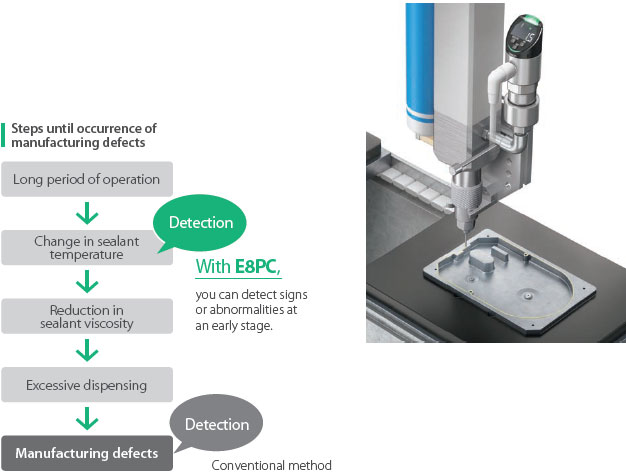

Multi-sensing technology
[Pressure]
Uses a piezoelectric element. Since the sensing surface is made of a high-hard ceramics, it withstands high pressure. Pressure values are detected from changes in resistance of the strain gauge.
[Temp.]
The temperature measuring element mounted to the back of the piezoelectric element measures temperature.

Notifications of changes in the cooling water or hydraulic oil states are easy to understand
You can see the cause of the abnormality Multi-sensing display [Patent pending]*1
The sensor judges by monitoring "Flow rate + Temperature" and "Pressure + Temperature". Since data outputs to a PLC by the IO-Link communications is possible, it is easy to perform maintenance before entering an abnormal state. For the display colors, you can set 3 patterns, or if combined with Not lit, a total of 4 patterns.
*1. “Patent pending” means that we applied for a patent in Japan, and “Patented” means that we obtained a patent in Japan. (As of July 2022)

Easy to understand Display by unit
Converts to physical quantity units for display.

Adjustable to reference flow rate Scaling function
Detected flow rate values can be adjusted to reference flow rates (red line) of the application. This function is useful when detected flow rates deviate from reference values.

Easy to see High luminosity LED display
A high luminosity LED gives good visibility even at the back of equipment or in dark locations.

Even if the sensor is installed in dark locations or at the back of equipment at manufacturing sites, a high luminosity LED enables you to easily read the status. You can immediately tell which sensor is showing signs of abnormalities by the colors of the indicators.

Adjust the angle according to the mounting position
Angle adjustment up to 330°
After fastening to the adapter, you can adjust the angle so that the display is easy to see.

180° reverse display
The display can rotate 180°.

Useful functions to capture equipment status
Peak/Bottom Hold function
Data at the moment when an error occurs can be identified even if no one is on site.
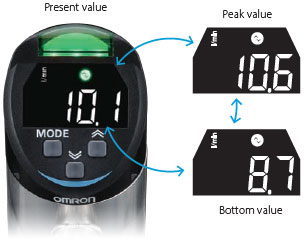
NPN/PNP selection
The output polarity can be easily switched with a button, eliminating the need to use different sensors for each polarity.
This means that maintenance stock can be reduced.
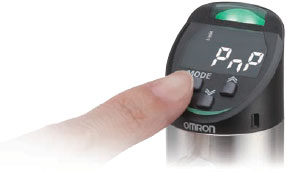
Two-channel analog current output
Both flow rate or pressure values and temperature values can be output as analog currents at the same time, which enables simultaneous monitoring of two physical quantities even in equipment using only analog input devices.
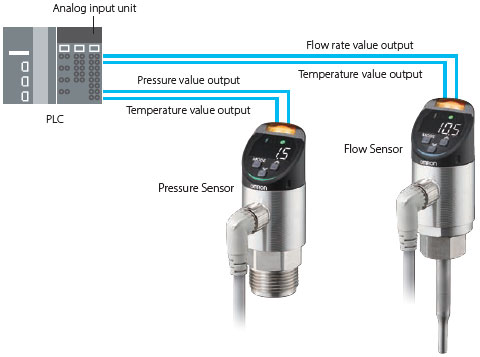
You can also see the sensor status Self-diagnostic outputs

Self-diagnoses the sensor's own status, and autonomously sends notification when signs of a connection error or a malfunction appears.

Batch setting from host devices

During maintenance, the settings must be the same conditions as when the product was initially mounted. If you use the IO-Link function, you can perform batch setting from a host device. You can manage by quantifying the adjustment that is performed by skilled personnel to avoid affecting the manufacturing quality.

Easy visualization of on-site issues

Data can be easily collected from sensors installed in existing equipment and monitored remotely simply by connecting the sensors to Visualization Software F-Scape that highlights on-site issues.
Building a complex system and programming are no longer required.

Easy to use in various location
Compact and space-saving
You can even mount in narrow spaces with multiple pipes arrayed.
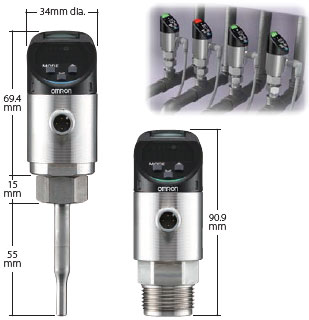
Expanded cable and adapter lineups (sold separately)*

* Use our dedicated adapters. In addition, if there is a possibility of pulsations or vibrations to a Pressure Sensor, we recommend the attachment of a throttle (sold separately).
Easy-to-clean structure
Structure is easily removable from the piping for periodic inspections, etc., and easily cleaned.

Highly durable liquid contact part

last update: August 1, 2022